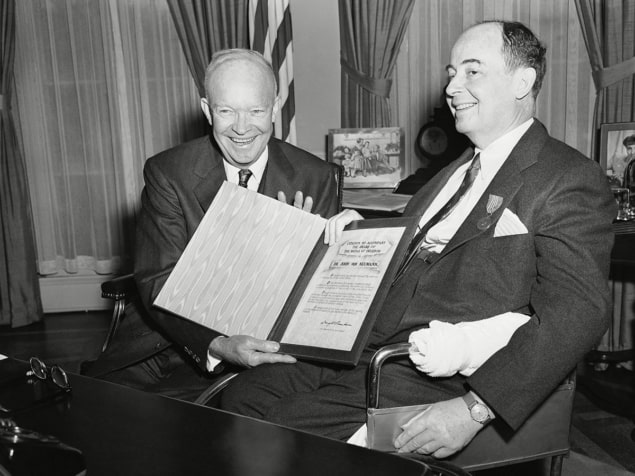Andrew Robinson reviews The Man from the Future: the Visionary Life of John von Neumann by Ananyo Bhattacharya

Few mathematicians during the last century – perhaps only Bertrand Russell and Alan Turing – were as successfully polymathic as John von Neumann, the subject of the biography The Man from the Future: the Visionary Life of John von Neumann by Ananyo Bhattacharya, a science writer and former medical researcher with training in physics and protein crystallography. His book is well researched with the encouragement of von Neumann’s daughter, Marina von Neumann Whitman. It is also engagingly written, and mostly accessible to non-mathematicians, though it is inevitably intellectually demanding, ranging from the intricacies of quantum mechanics to the origins of electronic computing. As the author himself admits, with reference to a famous comment by Isaac Newton, “This book perches precariously on the shoulders of many giants.”
Born Neumann János in Budapest, Hungary, in 1903, von Neumann helped to lay the mathematical foundations of quantum mechanics in the late 1920s, while working in Germany (where he acquired the German form of his name). After moving to Princeton, US, in 1930, he was among the key scientists who worked on the Manhattan Project to build the atomic bomb. Around the same time, von Neumann published a treatise, Theory of Games and Economic Behavior, with the economist Oskar Morgenstern. Coining the phrase “zero-sum game”, the treatise would change economics and introduce game theory into political science, military strategy, psychology and evolutionary biology.
Post-war, von Neumann helped to design the world’s first programmable electronic digital computer, intended to make calculations about the hydrogen bomb. Then, in 1948, his automata theory launched the idea of information-processing machines capable of reproducing, growing and evolving. In the 1950s, his consideration of the workings of brains and computers made him a visionary thinker in artificial intelligence. Unfortunately, he could take this no further, because he died prematurely in 1957, aged 53, from cancer. Even so, writes Bhattacharya, “His thinking is so pertinent to the challenges we face today that it is tempting to wonder if he was a time traveller, quietly seeding ideas that he knew would be needed to shape the Earth’s future.”
His private life was less productive and rewarding, however. After von Neumann’s death, his second wife, computer scientist Klára Dán, who remarried for the fourth time before taking her own life in 1963, penned an unfinished memoir. Quoted in Marina von Neumann Whitman’s 2012 book, The Martian’s Daughter, the memoir’s chapter entitled “Johnny” opens as follows: “I would like to tell about the man, the strange contradictory and controversial person; childish and good-humoured, sophisticated and savage, brilliantly clever yet with a very limited, almost primitive lack of ability to handle his emotions – an enigma of nature that will have to remain unresolved.”
Von Neumann was one of a group of brilliant Hungarian mathematicians and physicists, including Leo Szilard, Edward Teller and Eugene Wigner, born around the turn of the century, who emigrated to the US and in many cases worked on the Manhattan Project. Most were from Jewish families, and humorously dubbed themselves “Martians” because they were outsiders to American society, apparently superhuman in intellect, speaking an incomprehensible native language and coming from a small obscure country.
Tellingly, von Neumann attributed their academic success to “a coincidence of some cultural factors” that created “a feeling of extreme insecurity in the individuals, and the necessity to produce the unusual or face extinction”. In other words, comments Bhattacharya, “their recognition that the tolerant climate of Hungary might change overnight” – as happened murderously in the White Terror of 1919–1921 – “propelled some to preternatural efforts to succeed”. Mathematics and physics were considered safe choices for Jews who wished to excel academically, because these subjects were viewed at that time as being relatively harmless and reasonably well rewarded. This is why the 1919 experimental proof of Einstein’s theory of general relativity was internationally honoured despite his Jewishness.
Both Einstein and von Neumann, who was 24 years his junior, settled at Princeton’s Institute for Advanced Study after it was established in 1930, and remained there until their deaths. But they responded to the place, and to America, in hugely polarized ways – as illustrated by von Neumann’s habit of playing German marching tunes at top volume on his office phonograph, provoking complaints from neighbouring offices, including Einstein’s. According to his friend Wigner, von Neumann “felt at home in America from the first day. He was a cheerful man, an optimist who loved money and believed firmly in human progress. Such men were far more common in the United States than in the Jewish circles of central Europe.”

A relative journey
Hence von Neumann’s emotional commitment to the atomic and hydrogen bombs and America’s Cold War against the Soviet Union – not to speak of his immunity to McCarthyite witch-hunts of Communist sympathizers. Einstein, by contrast, famously never felt at home in America, had little taste for money and deliberately avoided society in Princeton, including von Neumann’s splendid parties where guests were served by liveried footmen. Never a part of the Manhattan Project, Einstein instead suffered secret investigation by the FBI following his televised attack on the presidential decision to develop the hydrogen bomb in 1950. This revealing comparison deserves mention by Bhattacharya, who barely refers to Einstein in Princeton.
The two of them agreed in at least one key respect beyond science, however: their loathing for Nazism, and its destruction of their earlier love of Europe. Einstein refused to visit the continent after 1933. Von Neumann returned in 1949, but wrote to his wife: “I feel the opposite of nostalgia for Europe, because every corner reminds me…of the world which is gone, and the ruins of which is no solace. My second reason for disliking Europe is the memory of my total disillusionment with human decency between 1933 and September 1938.”
Von Neumann accepted that there was no “complete recipe” for avoiding human extinction by technological means
Towards the end, as cancer got hold of him and just before he received in 1956 a Medal of Freedom from President Dwight Eisenhower for his technical contributions to national defence, von Neumann asked in an article in Fortune magazine, “Can we survive technology?” The article was naturally preoccupied with the destructive potential of more powerful weapons, faster computers and more rapid telecommunications. But it presciently noted the climatic impact of rising carbon-dioxide emissions, too. Von Neumann favoured introducing new geo-engineering technologies, which he thought would unite nations more than the threat of nuclear war. Yet he accepted that there was no “complete recipe” for avoiding human extinction by technological means. “We can specify only the human qualities required,” he wrote, “patience, flexibility, intelligence.”
- 2021 Allen Lane £20hb 368pp



